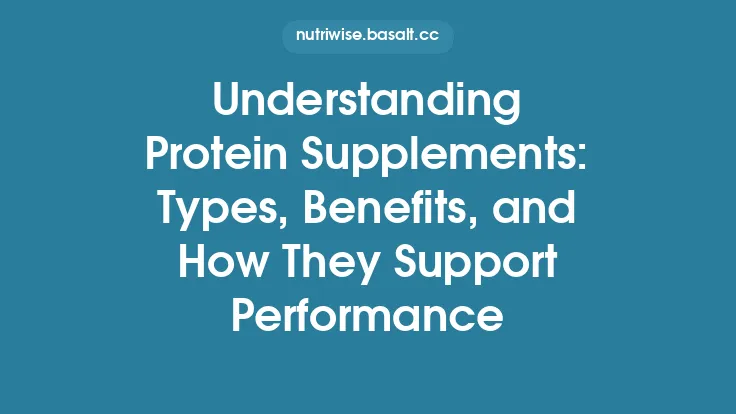Protein supplements have become a staple in many athletes’ and fitness enthusiasts’ routines, yet the underlying reasons they are so effective often remain hidden behind marketing claims and anecdotal advice. This guide cuts through the noise to explain, in a timeless and evidence‑based manner, how protein supplementation directly supports muscle recovery and growth. By understanding the physiological pathways, the role of specific amino acids, and how to align supplementation with training demands, readers can make informed decisions that stand the test of time.
The Science Behind Muscle Protein Synthesis
When a muscle fiber experiences mechanical tension—whether from a heavy squat, a sprint, or a high‑intensity interval—it triggers a cascade of intracellular events that culminate in muscle protein synthesis (MPS). MPS is the process by which new contractile proteins (actin, myosin) and structural proteins (titin, nebulin) are assembled, repairing micro‑damage and ultimately leading to hypertrophy when MPS exceeds muscle protein breakdown (MPB) over time.
Key molecular players include:
| Component | Function |
|---|---|
| mTORC1 (mechanistic target of rapamycin complex 1) | Central regulator that integrates mechanical, hormonal, and nutritional signals to initiate translation of mRNA into protein. |
| p70S6K (ribosomal protein S6 kinase) | Downstream of mTORC1; phosphorylates ribosomal proteins to boost protein synthesis. |
| 4E‑BP1 (eukaryotic translation initiation factor 4E‑binding protein 1) | When phosphorylated by mTORC1, releases eIF4E, allowing cap‑dependent translation to proceed. |
| AMPK (AMP‑activated protein kinase) | Energy sensor that can inhibit mTORC1 when cellular ATP is low, balancing anabolic and catabolic processes. |
Resistance training alone activates mTORC1, but the magnitude and duration of this activation are markedly amplified when essential amino acids (EAAs) are present in the bloodstream. Protein supplements provide a rapid, concentrated source of these amino acids, ensuring that the signaling machinery has the substrates it needs to translate the anabolic signal into actual protein accretion.
Key Amino Acids Driving Anabolic Signaling
Not all amino acids are created equal when it comes to stimulating MPS. While a full complement of EAAs is required for new protein synthesis, three amino acids exert outsized influence on the mTORC1 pathway:
- Leucine – Often called the “trigger amino acid,” leucine directly binds to the sestrin2 protein, relieving its inhibition of the GATOR2 complex, which in turn activates mTORC1. Research consistently shows that a leucine dose of ~2–3 g is sufficient to maximally stimulate MPS in most adults.
- Isoleucine – Though less potent than leucine, isoleucine contributes to the regulation of glucose uptake and can modulate insulin signaling, indirectly supporting an anabolic environment.
- Valine – Valine participates in nitrogen balance and helps maintain plasma amino acid concentrations, preventing the catabolism of other EAAs.
Beyond the branched‑chain amino acids (BCAAs), lysine, methionine, and threonine are essential for the synthesis of collagen and other extracellular matrix proteins that reinforce muscle architecture during recovery. Glutamine, while technically non‑essential, becomes conditionally essential under intense training stress and supports immune function, which can indirectly affect recovery quality.
Optimal Dosage Strategies for Different Training Demands
The amount of protein needed to maximize MPS varies with body size, training intensity, and the phase of training (e.g., hypertrophy vs. strength). While individual needs can be fine‑tuned, several dose‑response studies provide clear, evergreen guidelines:
| Training Context | Recommended Protein per Serving | Frequency per Day |
|---|---|---|
| General resistance training (moderate volume) | 0.25–0.30 g/kg body weight | 3–4 servings |
| High‑volume hypertrophy cycles | 0.30–0.35 g/kg body weight | 4–5 servings |
| Strength/power focus (low volume, high load) | 0.20–0.25 g/kg body weight | 3–4 servings |
| Concurrent endurance + resistance | 0.30 g/kg body weight (adjusted for total daily intake) | 4–5 servings |
For a 80 kg athlete, a typical “muscle‑building” dose would be 24–28 g of high‑quality protein per serving, delivered 3–5 times throughout the day. Importantly, the dose should be sufficient to raise plasma leucine concentrations above the ~2 mmol/L threshold that maximally activates mTORC1.
Interaction with Resistance Training Variables
Protein supplementation does not act in isolation; its efficacy is amplified when paired with specific training variables:
- Load and Volume – Higher mechanical loads generate greater mTORC1 activation, creating a larger “window of opportunity” for amino acids to be incorporated into new protein. Consequently, athletes performing heavy, low‑rep work may benefit from slightly larger protein doses per session to fully capitalize on this heightened signaling.
- Training Frequency – When training a muscle group multiple times per week, distributing protein intake evenly across those sessions helps maintain a consistently positive net protein balance, preventing periods of net catabolism that could blunt hypertrophy.
- Periodization – During deload weeks or taper phases, the overall anabolic stimulus from training diminishes. Maintaining baseline protein intake (≈1.6 g/kg/day) ensures that the muscle remains in a net anabolic state, preserving gains while recovery demands are lower.
- Recovery Modalities – Techniques such as foam rolling, contrast baths, or active recovery can reduce perceived soreness but have minimal impact on the biochemical drivers of MPS. Protein supplementation remains the primary nutritional lever for actual tissue repair.
Recovery Phases and the Role of Protein Supplementation
Recovery can be conceptualized in three overlapping phases, each with distinct metabolic demands:
- Immediate Post‑Exercise Phase (0–2 h) – Glycogen resynthesis and rapid MPS are at their peak. A protein dose rich in leucine, combined with carbohydrate (if glycogen restoration is a priority), accelerates the restoration of intracellular energy stores and initiates repair.
- Intermediate Phase (2–24 h) – Inflammatory cytokines gradually subside, and satellite cells proliferate. Continued provision of EAAs supports the translation of newly transcribed mRNA into structural proteins. Spacing protein intake every 3–4 h maintains elevated plasma amino acid levels, sustaining MPS.
- Long‑Term Remodeling Phase (24 h + ) – Collagen synthesis and extracellular matrix remodeling become prominent. Amino acids such as proline, glycine, and lysine (often abundant in collagen‑rich supplements) can be beneficial, though they are not strictly required for contractile protein synthesis.
By aligning supplementation with these phases—delivering a leucine‑rich dose immediately after training, followed by regular protein feedings throughout the day—muscle tissue receives the building blocks it needs at each critical juncture.
Monitoring Adaptations and Adjusting Supplementation
Even with a solid scientific foundation, individual responses can vary. Tracking both performance metrics and physiological markers helps fine‑tune protein strategies:
- Performance Indicators – Increases in one‑rep max, volume‑load capacity, or sprint times suggest a positive net protein balance. Plateaus may indicate insufficient protein, inadequate recovery, or overtraining.
- Body Composition – Regular DEXA or bioelectrical impedance assessments can reveal lean mass gains versus fat accretion, guiding adjustments in total protein versus caloric intake.
- Biomarkers – Blood urea nitrogen (BUN) and creatinine can provide a rough gauge of protein utilization and renal load. Elevated BUN without corresponding performance gains may signal excess protein relative to needs.
- Subjective Measures – Perceived muscle soreness, sleep quality, and overall energy levels are valuable, low‑cost indicators of recovery status.
When any of these signals suggest suboptimal recovery, modestly increasing protein dose (by 10–15 %) or redistributing feedings can often restore progress without drastic changes to the overall diet.
Safety, Tolerability, and Long‑Term Considerations
Protein supplements are generally safe for healthy adults when consumed within recommended ranges (1.2–2.2 g/kg/day for active individuals). However, certain considerations merit attention:
- Renal Function – In individuals with pre‑existing kidney disease, high protein intakes can exacerbate renal workload. Routine monitoring of glomerular filtration rate (GFR) is advisable for those with known renal concerns.
- Digestive Comfort – Some people experience bloating or gas with certain protein sources (e.g., lactose‑containing whey). Selecting hydrolyzed or isolate forms, or opting for non‑dairy alternatives, can mitigate these issues.
- Micronutrient Balance – Excessive protein can displace other macronutrients, potentially leading to deficiencies in essential fatty acids or fiber. A balanced diet that includes whole foods alongside supplements ensures comprehensive nutrient coverage.
- Sustainability – From an environmental perspective, plant‑based protein powders typically have a lower carbon footprint than animal‑derived options. While the guide does not focus on source selection, athletes mindful of sustainability may consider this factor when choosing supplements.
Long‑term adherence is often driven by convenience and palatability. Selecting a supplement that mixes well, tastes acceptable, and fits into daily routines enhances consistency, which is the most critical factor for chronic adaptations.
Special Populations: Aging, Women, and Endurance Athletes
Older Adults
Sarcopenia—the age‑related loss of muscle mass—accelerates after the fifth decade of life. Older individuals exhibit “anabolic resistance,” meaning they require higher leucine concentrations to achieve the same MPS response as younger adults. Practical recommendations include:
- Higher Per‑Meal Dose – 0.40 g/kg body weight per serving, with at least 3 g of leucine.
- Inclusion of Fast‑Digesting Proteins – To quickly raise plasma amino acid levels, especially after resistance sessions.
Female Athletes
Hormonal fluctuations across the menstrual cycle can modestly affect protein metabolism, with slightly higher protein oxidation observed during the luteal phase. Adjusting intake by 5–10 % during this window can help maintain a positive net protein balance.
Endurance‑Focused Athletes
While the primary goal may be aerobic performance, endurance training still induces muscle damage, especially during high‑intensity intervals or hill repeats. Protein supplementation (≈1.6 g/kg/day) supports repair of type I fibers and helps preserve lean mass during periods of high caloric expenditure.
Emerging Research and Future Directions
The field continues to evolve, with several promising avenues that may refine how we use protein supplements for recovery and growth:
- Peptide‑Based Supplements – Short chains of amino acids (e.g., di‑ and tripeptides) may be absorbed more rapidly than free amino acids, potentially offering a more efficient leucine spike.
- Chrononutrition – Investigations into circadian influences on mTORC1 activity suggest that aligning protein intake with the body’s natural anabolic peaks (often in the early afternoon) could modestly enhance MPS.
- Synergistic Nutrients – Compounds such as omega‑3 fatty acids, curcumin, and vitamin D have been shown to modulate inflammation and mTOR signaling. Future formulations may combine these with protein to create “next‑generation” recovery blends.
- Personalized Nutrition Algorithms – Machine‑learning models that integrate genetics, training load, and metabolic data could eventually prescribe individualized protein dosing schedules, moving beyond the one‑size‑fits‑all approach.
Staying abreast of these developments will allow athletes and coaches to continuously refine supplementation strategies, ensuring that the foundational principles outlined here remain effective as science advances.
In summary, protein supplements enhance muscle recovery and growth by delivering the essential amino acids—particularly leucine—that activate the mTORC1 pathway, sustain muscle protein synthesis, and support the multi‑phase repair process that follows resistance training. By applying evidence‑based dosage guidelines, aligning intake with training variables, monitoring individual responses, and considering safety and special‑population needs, athletes can harness protein supplementation as a reliable, evergreen tool for long‑term performance gains.





